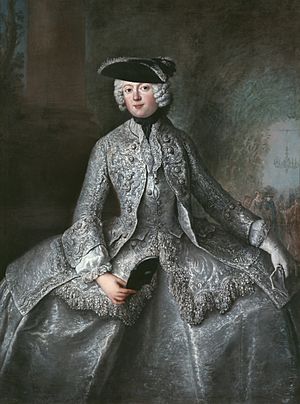Anna Amalia, Abbess of Quedlinburg facts for kids
|
||||||||||||||||||||||||||
Princess Anna Amalia of Prussia (born November 9, 1723 – died March 30, 1787) was a talented composer. She also held an important position as the Princess-Abbess of Quedlinburg. Anna Amalia was one of ten children of King Frederick William I of Prussia and Sophia Dorothea of Hanover.
Contents
Early Life and Music
Anna Amalia was born in Berlin. She was much younger than her brother, who later became King Frederick II. Both Anna Amalia and her brother loved music.
However, their father did not like music at all. Anna Amalia could only start formal music lessons after his death. Music became a secret comfort for her during difficult times.
She learned to play the harpsichord, flute, and violin. Her first music lessons were from her brother. Their mother, who was more understanding, encouraged their musical interests.
Marriage Plans
At one point, people thought Anna Amalia might marry the crown prince of Sweden. Her sister, Louisa Ulrika, was also considered. Her brother, King Frederick, thought Louisa Ulrika was too ambitious.
He believed Anna Amalia would be a better queen for Sweden. Sweden was a monarchy with less power at that time. King Frederick described Louisa Ulrika as "arrogant" and "an intriguer." He felt Anna Amalia was milder and "more suitable." Some think he wanted Anna Amalia to be easier to control as a Prussian agent. However, the Swedish representatives chose Louisa Ulrika instead.
Abbess and Musician
In 1755, Anna Amalia became the Abbess of Quedlinburg. This role made her quite wealthy. She chose to spend most of her time in Berlin. There, she focused on her passion for music.
She became known for supporting other musicians and for her own compositions. She gained some fame as a composer. Her most known works are smaller pieces for chamber music. These included trios, marches, songs, and fugues.
In 1758, Anna Amalia started studying music theory seriously. Her teacher was Johann Philipp Kirnberger, who had studied with Johann Sebastian Bach. She wrote chamber music, like flute sonatas. She also enjoyed religious music more than her brother did.
Her favorite composition was a cantata called Der Tod Jesu ("The Death of Jesus"). She set the words by Ramler to music. Only a few of her works have survived today. She might have destroyed many of her own pieces. She often described herself as being very "timid and self-critical."
However, more of her music might be found in the future. In 2000, the Sing-Akademie zu Berlin music archives were discovered in Kyiv. This collection had been lost since World War II.
Anna Amalia's Music Collection
Anna Amalia was also a dedicated collector of music. She saved over 600 volumes of works by famous composers. These included Johann Sebastian Bach, George Frideric Handel, and Carl Philipp Emanuel Bach. Her work in collecting and preserving these pieces was very important for Western culture.
Her large music library was divided after World War II. One part went to East Germany and the other to West Germany. After Germany reunited in 1990, the two collections came back together. This amazing collection has about 2,000 volumes. Today, it is kept at the Staatsbibliothek zu Berlin. This is not the same as the Duchess Anna Amalia Library in Weimar.
Selected Compositions
Concerto for Harpsichord and Orchestra, G major
- This piece is a chamber concerto. It can be played with just one musician for each part.
- The solo harpsichord part fits well with the rest of the music.
- The music has a lively and joyful feel.
- The slow part is mostly for the orchestra.
- The last part is like a Minuet dance with wind instrument solos.
Divertimento for Piano, Clarinet, Viola, and Cello, around 1780
- The exact story behind this Divertimento is not known.
- It combines formal style with a warm feeling.
- This might be the first chamber music piece to feature a clarinet.
- After the opening, each instrument gets a chance to play on its own.
- The viola leads, the clarinet answers, and the piano finishes.
- This music is graceful, charming, and easy to enjoy.
Sonata in F for Flute and Continuo
- This is a piece for flute and a continuo instrument, like a harpsichord or cello.
18th and 19th Century Songs
- These songs were inspired by the famous writer Goethe.
Images for kids
-
This 1729 painting by Antoine Pesne shows a visit from Augustus II the Strong. He was the Elector of Saxony and King of Poland. Anna Amalia's mother is in the middle. Her sisters are on the queen's right. A 6-year-old Anna Amalia is on the left, wearing light blue.
See also
 In Spanish: Ana Amalia de Prusia para niños
In Spanish: Ana Amalia de Prusia para niños




